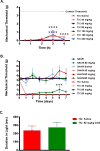Combination Drug Therapy of Pioglitazone and D-cycloserine Attenuates Chronic Orofacial Neuropathic Pain and Anxiety by Improving Mitochondrial Function Following Trigeminal Nerve Injury
- PMID: 28542026
- PMCID: PMC5701889
- DOI: 10.1097/AJP.0000000000000515
Combination Drug Therapy of Pioglitazone and D-cycloserine Attenuates Chronic Orofacial Neuropathic Pain and Anxiety by Improving Mitochondrial Function Following Trigeminal Nerve Injury
Abstract
Objectives: The study aim was to determine how peripheral trigeminal nerve injury affects mitochondrial respiration and to test efficacy of combined treatment with 2 Federal Drug Administration approved drugs with potential for improving mitochondrial bioenergetics, pain and anxiety-related behaviors in a chronic orofacial neuropathic pain mouse model.
Methods: Efficacy of (R)-(+)-4-amino-3-isoxazolidinone (D-cycloserine, DCS), an N-Methyl-D-aspartate antagonist/agonist, and Pioglitazone (PIO), a selective agonist of nuclear receptor peroxisome proliferator-activated receptor gamma was investigate in the trigeminal inflammatory compression (TIC) neuropathic nerve injury mouse model. Combined low doses of these drugs (80 mg/kg DCS and 100 mg/kg PIO) were given as a single bolus or daily for 7 days post-TIC to test ability to attenuate neuropathic nociceptive and associated cognitive dependent anxiety behaviors. In addition, beneficial effects of the DCS/PIO drug combination were explored ex vivo in isolated cortex/brainstem mitochondria at 28 weeks post-TIC.
Results: The DCS/PIO combination not only attenuated orofacial neuropathic pain and anxiety-related behaviors associated with trigeminal nerve injury, but it also improved mitochondrial bioenergetics.
Discussion: The DCS/PIO combination uncoupled mitochondrial respiration in the TIC model to improve cortical mitochondrial dysfunction, as well as reduced nociceptive and anxiety behaviors present in mice with centralized chronic neuropathic nerve injury. Combining these drugs could be a beneficial treatment for patients with depression, anxiety, or other psychological conditions due to their chronic pain status.
Figures






References
-
- Baad-Hansen L, Benoliel R. Neuropathic orofacial pain: Facts and fiction. Cephalalgia. First Published 12 Apr 2017. - PubMed
-
- De Leeuw R, editor. Orofacial Pain: Guidelines for Assessment, Diagnosis, and Management. Hanover Park, IL: Quintessence Publishing Co, Inc; 2008.
-
- Sui BD, Xu TQ, Liu JW, Wei W, Zheng CX, Guo BL, Wang YY, Yang YL. Understanding the role of mitochondria in the pathogenesis of chronic pain. Postgrad Med J. 2013;89:709–14. - PubMed
-
- Bouillot S, Martin-Negrier ML, Vital A, Ferrer X, Lagueny A, Vincent D, Coquet M, Orgogozo JM, Bloch B, Vita C. Peripheral neuropathy associated with mitochondrial disorders: 8 cases and review of the literature. J Peripher Nerv Syst. 2002;7:213–20. - PubMed
-
- Joseph EK, Levine JD. Mitochondrial electron transport in models of neuropathic and inflammatory pain. Pain. 2006;121:105–14. - PubMed
Publication types
MeSH terms
Substances
Grants and funding
LinkOut - more resources
Full Text Sources
Other Literature Sources
Medical

